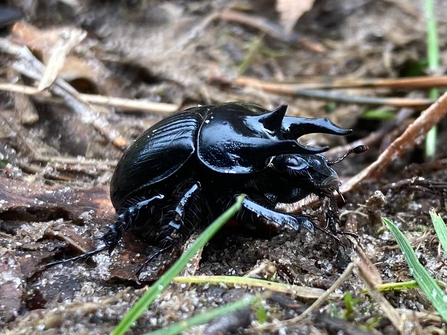The minotaur beetle is a large, round dung beetle found on sandy grassland and heathland. It is glossy black, with ridges running down the wing cases. Only the male dons the bull-like horns, the female has pointed edges where they would be.
The beetle feeds mostly on rabbit droppings and other dung, often at night. Adults emerge in autumn, but still need to mature in order to breed, so undergo an intense feeding period. If the weather is mild, they may start breeding in early winter. The males use their horns to compete for a mate and then subsequently defend the nest they make with the female to protect the larvae inside.
The minotaur beetle nests in tunnels that can be up to 1.5 metres deep, where they lay their eggs and provide dung for the larvae to feed on. Both the male and female provide food for the larvae, as you can imagine, this is dung. They drag it back to the nest using their strong front legs. By the following summer, the adults will die to make way for the next generation.


